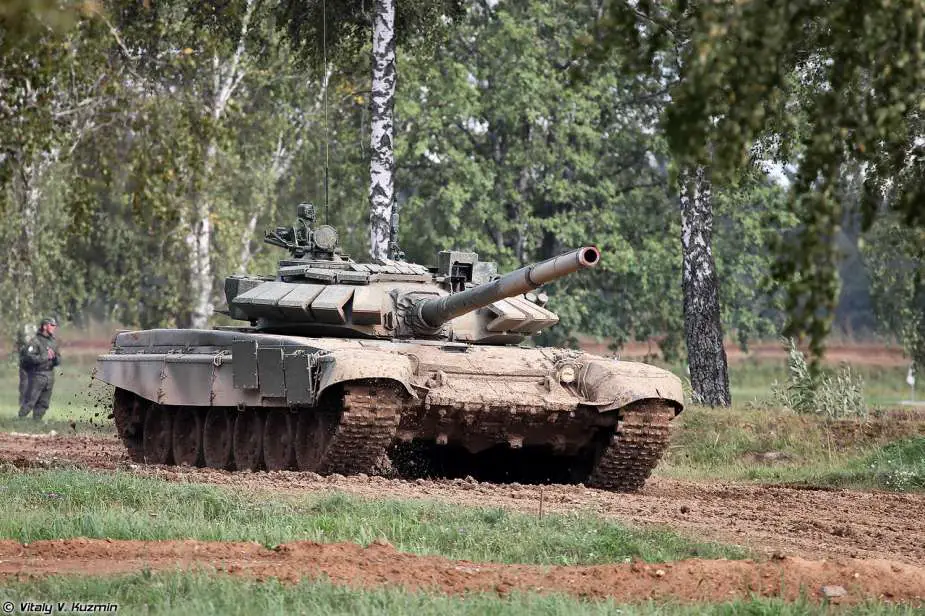- Army
- Conflicts in the world
- Israel - Iran conflict 2025
- Pakistan - India Conflict 2025
- Russia Ukraine War 2022
- Libya conflict day by day
- HAMAS - Israel War 2023
- Operation Serval in Mali French Army
- Sangaris operation Central African Republic
- Sangaris opération militaire République Centreafrique
- Ukraine - Russia conflict
- Syria conflict news
- Defence & Security Industry Technology
- Armies in the world
- Analysis Defense and Security Industry
- Conflicts in the world
- Navy
- Air
Russia tests Sturm unmanned T-72 tank for deployment in Ukraine
According to an article by Life.RU on September 10, 2023, Uralvagonzavod (UVZ) has initiated the testing phase of the Shturm unmanned combat robot, built on the T-72B3 tank chassis, and intended for deployment on the Ukrainian frontline. The development of this unmanned tank project by UVZ had commenced before the onset of the Ukrainian conflict, but recent developments seem to have accelerated its progress. The testing program involves live-fire exercises against various target scenarios, with a focus on the utilization of the robot's primary armament, a 125-millimeter shortened barrel gun.
Follow Army Recognition on Google News at this link

Russian T-72B3 during a demonstration in 2017 (Picture source: Vitaly Kuzmin)
The Sturm project, commissioned at the request of the Russian Ministry of Defense, draws on automation technologies from the T-14 Armata tank, which was also planned to be produced in an unmanned version. However, a decision was later made to base the new robotic tank on the older yet cost-effective T-72B3 platform.
The T-72B3 represents an upgraded iteration of the T-72B tank currently in service with the Russian army. Enhancements encompass a 125mm 2A46M-5 smoothbore gun, equipped with a light-alloy thermal sleeve and bore evacuator. The guided weapon system empowers both the gunner and commander to launch laser-guided missiles, including the 9M119 AT-11 'Svir' or 9M119M Refleks, for a maximum range of 5,000 meters during both day and night operations.
The "Sturm" unmanned tank project, based on the T-72 platform, encompasses four distinct combat vehicle types. The initial variant features a 125-millimeter gun with a shortened barrel, while the second variant is designed to accommodate missiles or a rocket-propelled infantry flamethrower with a thermobaric Shmel-M warhead.
The third iteration involves the transformation of the Terminator fire support vehicle into a robotic version, equipped with two 30-millimeter guns. Unlike the traditional Terminator, the robotic fire support vehicle will deploy thermobaric missiles instead of anti-tank missiles. At the Army-2023 forum, UVZ unveiled a T-72-based variant of the Terminator tank support vehicle (BMPT), presenting the possibility of upgrading decommissioned T-72 tanks into combat-ready vehicles, nearly matching the capabilities of the BMPT.
The fourth Sturm project envisions an unmanned vehicle operating in conjunction with the TOS-1A thermobaric rocket launcher system.
Russian military expert Yuri Knutov noted that the introduction of T-72-based drones could offer distinct advantages to the Russian Armed Forces. Unmanned tanks can advance under enemy fire, ensuring the safety of their crew, who remain outside the vehicle. Knutov mentioned that actual Sturm plans include four types of robots, subject to potential adjustments following testing. These robots were tested with two large-caliber machine guns and artificial intelligence systems.
The decision to employ the T-72B3 platform is influenced by its not-so-obsolete armor, complemented by the latest generation of dynamic protection systems currently deployed in Ukraine, which can significantly enhance the combat capabilities of unmanned tanks.
Furthermore, the integration of robots on the frontline may prompt a reevaluation of tactics involving tanks and heavy armored vehicles, especially in response to significant tank offensives. Knutov observed that despite a large number of armored vehicles, anti-tank guided missiles have proven highly effective in neutralizing them during the ongoing Ukraine conflict.
As said by Knutov, to optimize combat effectiveness, armored vehicles must be strategically deployed, such as in a tank carousel configuration comprising three vehicles, which seems more promising than deploying a large number of units.


























